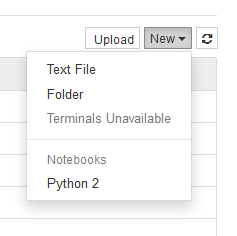Jupyter was originally derived from Python with the IPython project. At that time, Python 2 was the predominant version available for use. For every installation of Jupyter, the default engine provided is Python 2. There are a number of changes involved when moving from Python 2 to Python 3, especially in the underlying libraries that you may be invoking, where parameter and usage changes have occurred.
We will cover the installation of the Python 3 engine and make sure it is running with a script.
Assuming you have installed the standard Jupyter package, you now have Python 2 as the only engine available at the top of the Jupyter portal screen:

To upgrade to Python 3, I used the commands:
conda create -n py3k python=3 anaconda source activate py3k ipython kernelspec install-self
After this, when you start Jupyter, you will have the Python 3 engine choice.
You may prefer to have the Python 2 engine also available. This could...



